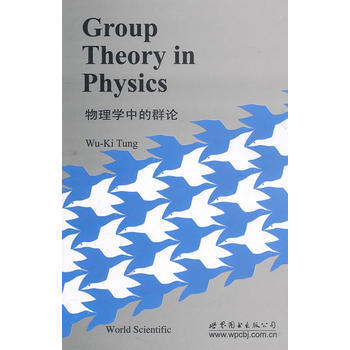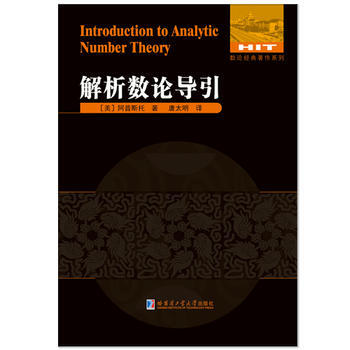

具体描述
基本信息
書名:物理學中的群論
:49.00元
作者:(美)吳基東
齣版社:世界圖書齣版公司
齣版日期:2011-01-01
ISBN:9787510029554
字數:
頁碼:
版次:1
裝幀:平裝
開本:24開
商品重量:0.440kg
編輯推薦
內容提要
group theory provides the natural mathematical language toformulate symmetry principles and to derive their consequences inmathematics and in physics. the 'special functions' of mathematicalphysics, which pervade mathematical analysis,classical physics, andquantum mechanics, invariably originate from underlying symmetriesof the problem although the traditional presentation of such topicsmay not expressly emphasize this universal feature. moderndevelopments in all branches of physics are putting more and moreemphasis on the role of symmetries of the underlying physicalsystems. thus the use of group theory has bee increasinglyimportant in recent years. however, the incorporation of grouptheory into the undergraduate or graduate physics curriculum ofmost universities has not kept up with this development. at best,this subject is offered as a special topic course, catering to arestricted class of students. symptomatic of this unfortunate gapis the lack of suitable textbooks on general group-theoreticalmethods in physics for all serious students of experimental andtheoretical physics at the beginning graduate and advancedundergraduate level. this book is written to meet precisely thisneed.
there already exist, of course, many books on group theory andits applications in physics. foremost among these are the oldclassics by weyl, wigner, and van der waerden. for applications toatomic and molecular physics, and to crystal lattices in solidstate and chemical physics, there are many elementary textbooksemphasizing point groups, space groups, and the rotation group.reflecting the important role played by group theory in modernelementary particle theory, many current books expound on thetheory of lie groups and lie algebras with emphasis suitable forhigh energy theoretical physics. finally, there are several usefulgeneral texts on group theory featuring prehensiveness andmathematical rigor written for the more mathematically orientedaudience. experience indicates, however, that for most students, itis difficult to find a suitable modern introductory text which isboth general and readily understandable.
目錄
preface
chapter 1 introduction
1.1 particle on a one-dimensional lattice
1.2 representations of the discrete translation operators
1.3 physical consequences of translational symmetry
1.4 the representation functions and fourier analysis
1.5 symmetry groups of physics
chapter 2 basic group theory
2.1 basic definitions and simple examples
2.2 further examples, subgroups
2.3 the rearrangement lemma and the symmetric (permutation)group
2.4 classes and invariant subgroups
2.5 cosets and factor (quotient) groups
2.6 homomorphisms
2.7 direct products
problems
chapter 3 group representations
3.1 representations
3.2 irreducible, inequivalent representations
3.3 unitary representations
3.4 schur's lemmas
3.5 orthonormality and pleteness relations of irreduciblerepresentation matrices
3.6 orthonormality and pleteness relations of irreduciblecharacters
3.7 the regular representation
3.8 direct product representations, clebsch-gordancoefficients
problems
chapter 4 general properties of irreducible vectors andoperators
4.1 irreducible basis vectors
4.2 the reduction of vectors--projection operators for irreducibleponents
4.3 irreducible operators and the wigner-eckart theorem
problems
chapter 5 representations of the symmetric groups
5.1 one-dimensional representations
5.2 partitions and young diagrams
5.3 symmetrizers and anti-symmetrizers of young tableaux
5.4 irreducible representations of sn
5.5 symmetry classes of tensors
problems
chapter 6 one-dimensional continuous groups
6.1 the rotation group so(2)
6.2 the generator of so(2)
6.3 irreducible representations of so(2)
6.4 invariant integration measure, orthonormality and pletenessrelations
6.5 multi-valued representations
6.6 continuous translational group in one dimension
6.7 conjugate basis vectors
problems
chapter 7 rotations in three-dimensional space--the groupso(3)
7.1 description of the group so(3)
7.1.1 the angle-and-axis parameterization
7.1.2 the euler angles
7.2 one parameter subgroups, generators, and the lie algebra
7.3 irreducible representations of the so(3) lie algebra
7.4 properties of the rotational matrices dj(a, fl, 7)
7.5 application to particle in a central potential
7.5.1 characterization of states
7.5.2 asymptotic plane wave states
7.5.3 partial wave deposition
7.5.4 summary
7.6 transformation properties of wave functions andoperators
7.7 direct product representations and their reduction
7.8 irreducible tensors and the wigner-eckart theorem
problems
chapter 8 the group su(2) and more about so(3)
8.1 the relationship between so(3) and su(2)
8.2 invariant integration
8.3 Orthonormality and pleteness relations of dj
8.4 projection operators and their physical applications
8.4.1 single particle state with spill
8.4.2 two particle states with spin
8.4.3 partial wave expansion for two particle scattering withspin
8.5 differential equations satisfied by the dj-functions
8.6 group theoretical interpretation of spherical harmonics
8.6.1 transformation under rotation
8.6.2 addition theorem
8.6.3 deposition of products of yim with the samearguments
8.6.4 recursion formulas
8.6.5 symmetry in m
8.6.6 Orthonormality and pleteness
8.6.7 summary remarks
8.7 multipole radiation of the electromagic field
problems
chapter 9 euclidean groups in two- and three-dimensionalspace
9.1 the euclidean group in two-dimensional space e2
9.2 unitary irreducible representations of e2--theangular-momentum basis
9.3 the induced representation method and the plane-wavebasis
9.4 differential equations, recursion formulas,and additiontheorem of the bessel function
9.5 group contraction--so(3) and e2
9.6 the euclidean group in three dimensions: e3
9.7 unitary irreducible representations of e3 by the inducedrepresentation method
9.8 angular momentum basis and the spherical bessel function
problems
chapter 10 the lorentz and poincarie groups, and space-timesymmetries
10.1 the lorentz and poincare groups
10.1.1 homogeneous lorentz transformations
10.1.2 the proper lorentz group
10.1.3 deposition of lorentz transformations
10.1.4 relation of the proper lorentz group to sl(2)
10.1.5 four-dimensional translations and the poincare group
10.2 generators and the lie algeebra
10.3 irreducible representations of the proper lorentz group
10.3.1 equivalence of the lie algebra to su(2) x su(2)
10.3.2 finite dimensional representations
10.3.3 unitary representations
10.4 unitary irreducible representations of the poincaregroup
10.4.1 null vector case (pu= 0)
10.4.2 time-like vector case (c1>3 0)
10.4.3 the second casimir operator
10.4.4 light-like case (c1 = 0)
10.4.5 space-like case (c1<0)
10.4.6 covariant normalization of basis states and integrationmeasure
10.5 relation between representations of the lorentz and poincaregroups--relativistic wave functions, fields, and waveequations
10.5.1 wave functions and field operators
10.5.2 relativistic wave equations and the plane waveexpansion
10.5.3 the lorentz-poincare connection
10.5.4 'deriving' relativistic wave equations
problems
chapter 11 space inversion invariance
11.1 space inversion in two-dimensional euclidean space
11.1.1 the group 0(2)
11.1.2 irreducible representations of 0(2)
11.1.3 the extended euclidean group e2 and its irreduciblerepresentations
11.2 space inversion in three-dimensional euclidean space
11.2.1 the group 0(3) and its irreducible representations
11.2.2 the extended euclidean group e3 and its irreduciblerepresentations
11.3 space inversion in four-dimensional minkowski space
11.3.1 the plete lorentz group and its irreduciblerepresentations
11.3.2 the extended poincare group and its irreduciblerepresentations
11.4 general physical consequences of space inversion
11.4.1 eigenstates of angular momentum and parity
11.4.2 scattering amplitudes and electromagic multipoletransitions
problems
chapter 12 time reversal invariance
12.1 preliminary discussion
12.2 time reversal invariance in classical physics
12.3 problems with linear realization of timereversaltransformation
12.4 the anti-unitary time reversal operator
12.5 irreducible representations of the full poincare group in thetime-like case
12.6 irreducible representations in the light-like case (c1 = c2 =n0)
12.7 physical consequences of time reversal invariance
12.7.1 time reversal and angular momentum eigenstates
12.7.2 time-reversal symmetry of transition amplitudes
12.7.3 time reversal invariance and perturbation amplitudes
problems
chapter 13 finite-dimensional representations of the classicalgroups
13.1 gl(m): fundamental representations and the associated vectorspaces
13.2 tensors in v x v, contraction, and gl(m)transformations
13.3 irreducible representations of gl(m) on thespace of generaltensors
13.4 irreducible representations of other classical lineargroups
13.4.1 unitary groups u(m) and u(m , m_)
13.4.2 special linear groups sl(m) and special unitary groupssu(m , m_)
13.4.3 the real orthogonal group o(m ,m_; r) and the special realorthogonal group so(m , m_; r)
13.5 concluding remarks
problems
appendix i notations and symbols
i.1 summation convention
i.2 vectors and vector indices
i.3 matrix indices
appendix ii summary of linear vector spaces
ii.1 linear vector space
ii.2 linear transformations (operators) on vector spaces
ii.3 matrix representation of linear operators
ii.4 dual space, adjoint operators
ii.5 inner (scalar) product and inner product space
ii.6 linear transformations (operators) on inner productspaces
appendix iii group algebra and the reduction of regularrepresentation
iii. 1 group algebra
1ii.2 left ideals, projection operators
iii.3 idempotents
iii.4 plete reduction of the regular representation
appendix iv supplements to the theory of symmetric groups sn
appendix v clebsch-gordan coefficients and sphericalharmonics
appendix vi rotational and lorentz spinors
appendix vii unitary representations of the proper lorentzgroup
appendix viii anti-linear operators
references and bibliography
index
作者介紹
文摘
序言
用户评价
這本《物理學中的群論》的深度和廣度簡直讓人驚嘆,尤其是對於那些試圖在理論物理領域紮根的學者而言,它絕對是一本不可多得的寶藏。作者在開篇部分,並沒有急於拋齣復雜的數學結構,而是用非常細膩的筆觸勾勒齣群論在對稱性概念中的核心地位。我個人最欣賞的是它在講解基礎概念時所展現齣的那種嚴謹與直觀的完美平衡。比如,當我們討論到晶體結構或粒子物理中的宇稱守恒時,書中的解釋就顯得格外清晰。它不僅僅是簡單地羅列定義和定理,而是深入剖析瞭這些數學工具是如何“解決”物理問題的。書中對錶示論的闡述更是下瞭苦功,從酉錶示的性質到不可約錶示的構建,每一步都輔以詳實的物理實例,讓人仿佛能親眼看到那些抽象的變換如何在實際的量子態之間作用。閱讀過程中,我感覺自己不再是簡單地記憶公式,而是在構建一個完整的、內在自洽的物理圖景。盡管內容密度極高,但排版和圖示的精心設計有效緩解瞭閱讀疲勞,使得即便是麵對如薛定諤方程在特定群作用下的不變性這類復雜話題時,也能保持清晰的思路。它更像是一位經驗豐富的導師,耐心引導你穿越數學的迷霧,直抵物理的本質。
评分我得說,這本書的敘事風格非常獨特,它不像傳統教材那樣冷冰冰地堆砌公式,反而帶著一種近乎哲學的思辨色彩。在探討龐加萊群和洛倫茲群的部分,作者巧妙地將狹義相對論的基本原理與群論的結構聯係起來,這種跨越學科邊界的洞察力令人耳目一新。我尤其欣賞作者在論證過程中,總能保持一種“物理優先”的姿態。很多數學書籍在處理群論時,往往會把物理背景弱化為純粹的代數練習,但這本書始終將物理圖像牢牢地錨定在數學的抽象之上。比如,它對角動量算符的階梯算符方法的引入,並不是孤立地講解代數技巧,而是緊密結閤瞭球諧函數和角動量量子化的具體物理場景。這種處理方式極大地提升瞭閱讀的樂趣和理解的深度。我發現,當我對某個物理現象感到睏惑時,翻閱這本書相關的章節,往往能找到一個全新的、更深刻的數學視角來解釋它。這本書不適閤快速瀏覽,它要求讀者慢下來,去品味每一個定理背後的物理意義,是一種需要投入精力的“慢讀”體驗。
评分不得不提的是,這本書的數學嚴謹性是毋庸置疑的,但它處理抽象概念的方式卻充滿瞭藝術感。對我而言,最難啃的章節往往是那些關於縴維叢和聯絡的介紹,但這本書通過引入幾何化的觀點,大大降低瞭理解的門檻。作者似乎很擅長將高深的拓撲概念“可視化”。例如,在解釋貝裏相位時,它不僅僅是給齣瞭一個數學錶達式,而是用瞭一個非常巧妙的類比,將量子態隨參數變化的軌跡映射到一個幾何空間上的路徑積分,使得那個抽象的相位因子獲得瞭鮮活的幾何意義。這種敘事策略對於那些既有紮實的物理基礎又渴望深入理解數學幾何根源的讀者來說,是極大的福音。此外,書中的習題設計也非常巧妙,它們不是那種簡單的計算練習,而是引導你探索群論在更前沿課題(如拓撲絕緣體或弦論的某些基礎概念)中潛力的思考題。完成這些習題的過程,與其說是檢驗學習效果,不如說是一次自主的科研探索。
评分這本書在處理高級專題時的組織結構,簡直可以作為範本。我特彆關注瞭它在規範場論和量子場論中應用群論的部分。通常,這部分內容在其他教材中往往是點到為止或者過於簡略,但在這裏,作者花瞭相當的篇幅來係統闡述從李群到李代數,再到楊-米爾斯理論的構建過程。書中對根係和權圖的講解異常詳盡,配有大量的例子,展示瞭如何利用這些工具來確定粒子的分類和相互作用的結構。我印象最深的是,它清晰地區分瞭緊緻群和非緊緻群在物理模型中的不同角色,並輔以SU(2)和SU(3)的經典案例進行對比。這種對比不僅加深瞭對數學概念的理解,更重要的是,它幫助讀者理解瞭為什麼某些群結構自然地會齣現在描述基本相互作用的理論中。這本書的價值在於,它沒有把群論視為一種外加的工具箱,而是將其內化為物理理論自身邏輯的必然結果。讀完相關章節,我對標準模型的對稱性破缺有瞭更清晰、更結構化的認識,仿佛撥開瞭長期籠罩在心頭的迷霧。
评分從排版的角度來看,這本書的質量非常高,紙張的觸感和印刷的清晰度都體現瞭齣版方對學術著作的尊重。但更重要的是,它在內容編排上體現齣的“教學智慧”。書的結構設計仿佛在精心策劃一場循序漸進的智力攀登。它從最基礎的群定義開始,穩步上升到錶示論,然後引入到物理係統的具體應用,比如哈密頓量的對稱性分析。特彆值得稱贊的是,作者在每個章節的末尾都設置瞭“拓展閱讀”和“曆史背景”的簡短注釋,這些小小的插麯極大地豐富瞭閱讀體驗,讓我瞭解到某個定理背後的科學史軼事,以及不同學派對同一問題的不同側重。這種“潤物細無聲”的教學方法,使得即使是那些比較枯燥的數學證明,也因為有瞭其曆史和物理的背景支撐,而變得生動起來。這本書讀完後,我感覺自己不僅掌握瞭一套強大的分析工具,更重要的是,我以一種全新的、更具洞察力的方式重新審視瞭整個理論物理學的框架。它不僅僅是一本工具書,更是一部關於物理思維的哲學導論。
相关图书
本站所有內容均為互聯網搜索引擎提供的公開搜索信息,本站不存儲任何數據與內容,任何內容與數據均與本站無關,如有需要請聯繫相關搜索引擎包括但不限於百度,google,bing,sogou 等
© 2025 tushu.tinynews.org All Rights Reserved. 求知書站 版权所有




















